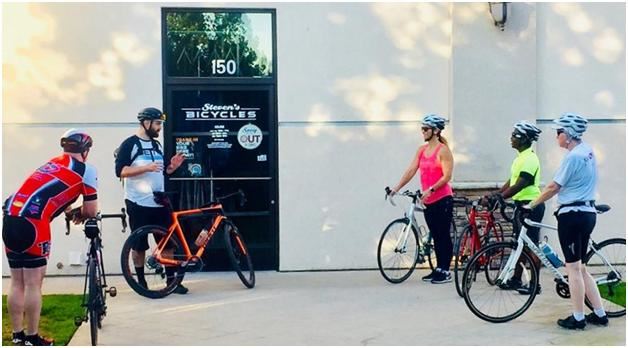Cleaning Your Bike
Let’s dive in and go over the most basic of maintenance topics: How to clean you bicycle, and how to care for it after the wash.
We'll start with some items that you will need to wash your bike with:
- A repair stand or some place to set your bike that allows you to easily reach all the areas of your bike without straining your back,
- A bucket with your favorite bike wash like Finish Line, Giant or any bike specific brand that you like. PLEASE... no dish soap!!
- Some water,
- Bike-specific washing tools like Park BCB-4.2 or Pedro’s brush kit. These kits should be available at any of our local bike shops.
- You will also need a few rags to dry the components and a separate one for the non-greasy parts of the bike.
- A bottle of Tri-Flow, chain lube, degreaser and your favorite polish/finisher but we will hit those later.
The first thing: set your bike in an area that will allow you to spray water and move completely around the bike. Once you get the perfect spot picked out, set up your repair stand and clamp the dirty bike in. If you’re comfortable with it, remove the front and rear wheels (This will allow you to clean the rear triangle and inside the fork easier). Now, grab the hose and put some of your favorite bike wash in a bucket and top it off with water. Since we have the hose out, let’s move over to the bike and with a light mist, spray your bike down.
Spray the wheels and all the greasy parts, keep the water at a minimum around the bottom bracket, headset and hubs since those areas contain bearings. Reach into your tool kit and grab the brush with the black bristles (this is for the gunked-up pulleys, rear derailleur, front derailleur, cassette, crankset, chain and any other greasy hard-to-reach areas). The bottle of degreaser will come in handy when cleaning these areas, since it will help to break down the dirty grease and keep the elbow grease to a minimum.
Once we have all greasy areas cleaned, spray them down one last time and move onto the other parts of the bike, to bring back that beautiful paint job! Using the soft brush, dip it into your bucket, and scrub under the bottom bracket, stem, handlebars, under the saddle, the entire frame and wheels. Keep going back to your bucket of cleaner until satisfied and then lightly mist the bike wash and gunk away. Take your rag for the greasy components and dry them first,:this is your chance to get the extra mess you may have missed. Now let’s dry the frame and wheels.
Since everything is now dry, take a step back and admire your work... great job! We aren’t quite done though. When we washed our bike, we also washed out all of the vital lubricants and frame protectant. Remember the Tri-Flow, chain lube and bike polish I mentioned? Here is when we apply those. Take your bottle of Tri-Flow with the little hose on it, and apply a couple of drips into the pivots on both derailleurs, pedals, rim brake pivots (Non-disc) and any other moving part of your bike (except the chain). Grab your favorite chain lube, and apply this as directed to the chain. Let it sit for a moment then wipe off the excess. The finishing step is to spray some bike polish on a clean rag and wipe down your bike frame and anywhere else you feel necessary.
That’s it! Now your bike is clean and ready to ride again.
Keeping your bike clean will help you learn about your bike. You will come to know every square inch of it, and possibly spot any issues before they become too serious. Keeping a clean drivetrain will also help extend the life of your drivetrain, improve shifting and keep the squeaks away. When we wash the wheels we also wash away the dirt that can grind down the brake pads and rim surface like sand paper extending the life of those as well. Keep your bike and parts clean, and they will reward you. If all of this seems like too much work bring it down and we can do a professional wash and lube job on it as well!
 Let’s dive into the world of bicycle maintenance, safety, preparedness, and all things associated with cycling. My goal with this blog is to engage our local cycling community in discussions and improve your knowledge of your own bicycles. I believe everyone should have the skills to change a flat and should be familiar with how their bicycle works, plus what to do in case of an emergency. Join me as we go on this adventure together. My name is Devin Bovee I am, a father, a cyclist, a bike mechanic, a bike shop Manager and an advocate for people to get on their bikes. Reach out to me via email Devin@stevensbicycles.com or give me a call 559.797.0148.
Let’s dive into the world of bicycle maintenance, safety, preparedness, and all things associated with cycling. My goal with this blog is to engage our local cycling community in discussions and improve your knowledge of your own bicycles. I believe everyone should have the skills to change a flat and should be familiar with how their bicycle works, plus what to do in case of an emergency. Join me as we go on this adventure together. My name is Devin Bovee I am, a father, a cyclist, a bike mechanic, a bike shop Manager and an advocate for people to get on their bikes. Reach out to me via email Devin@stevensbicycles.com or give me a call 559.797.0148.